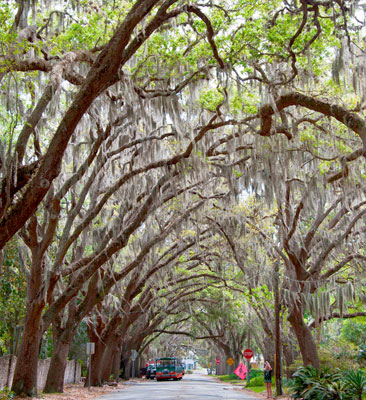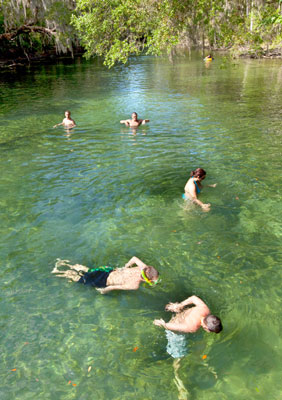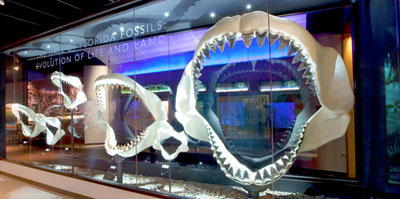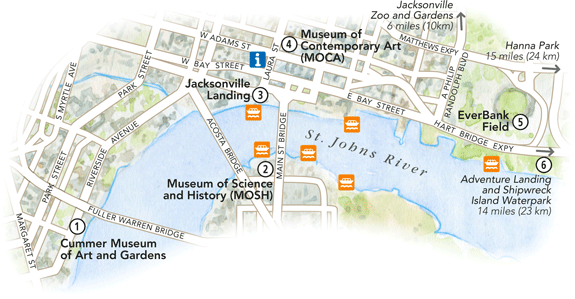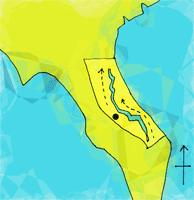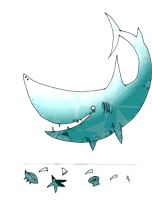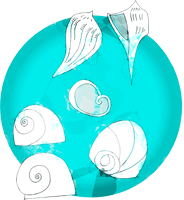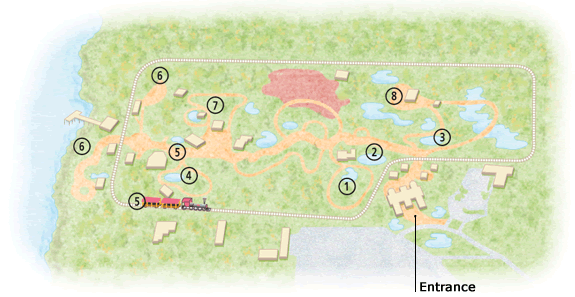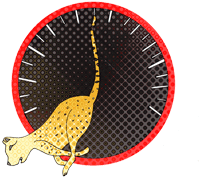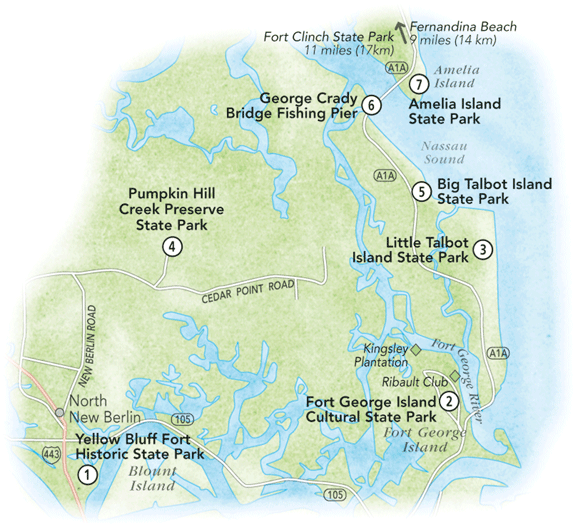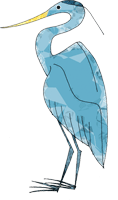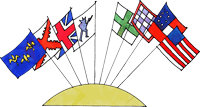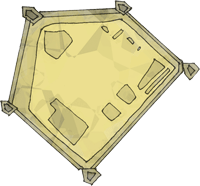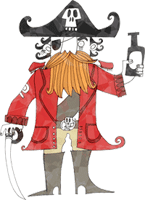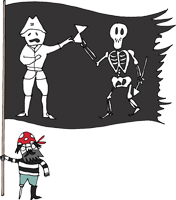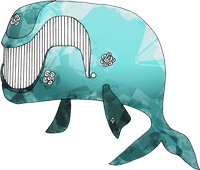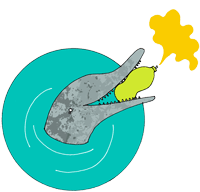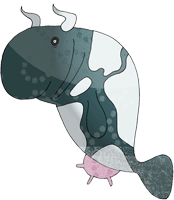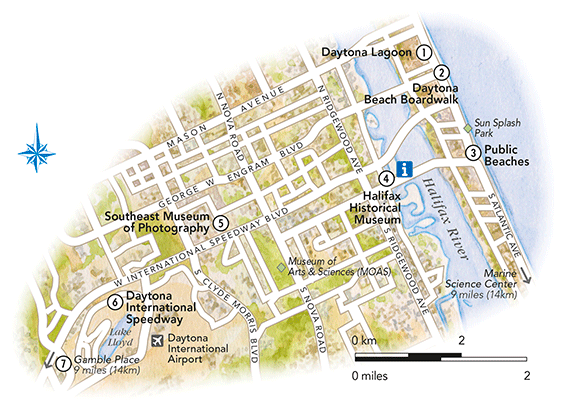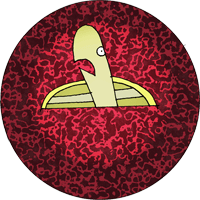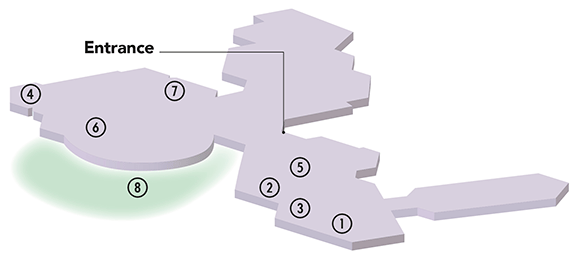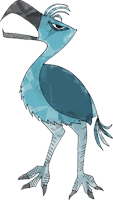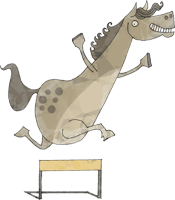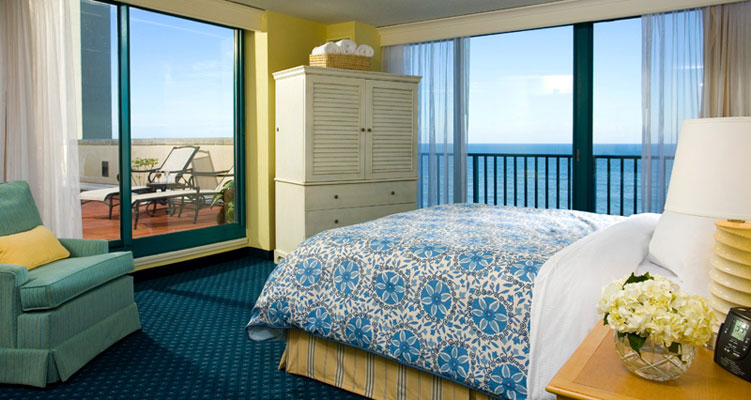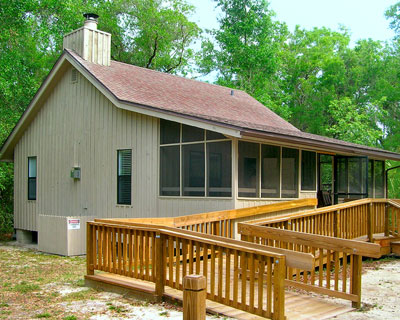< The Northeast
The Northeast
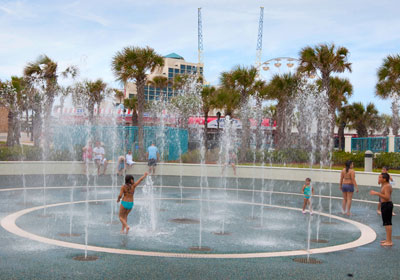
Splashing in the fountains near the Daytona Beach
Boardwalk
Some of the most intriguing views of Northeast Florida
can be found along SR A1A as it winds through a string of quirky beach
towns. Although it is hard to compete with 120 miles (193 km) of
white-sand beaches, this region has many other sights worth visiting.
Jacksonville and Daytona Beach offer the big-city experience; Fernandina
Beach is a quaint town with superb state parks nearby; and St. Augustine
boasts a venerable Spanish heritage. Jacksonville is the main
transportation hub for the region. Several east–west routes link the
coast and I-75, inland.
1. Jacksonville
2. Jacksonville Zoo
and Gardens
3. Talbot Islands
State Parks
4. Fernandina Beach
5. Fort Clinch
State Park
6. Cumberland
Island National Seashore
7. St. Augustine
8. Lightner
Museum/Ponce de León Hotel
9. Castillo de San
Marcos
10.
Environmental Education Center
11. Anastasia Island
12. Marineland
Dolphin Adventure
13. Washington Oaks
Gardens State Park
14. Daytona Beach
15. Museum of Arts
and Sciences (MOAS)
16. Blue Spring
State Park
17. Ocala National
Forest
18. Ocala
Thoroughbred Farm Country
19. Marjorie Kinnan
Rawlings Historic State Park
20. Paynes
Prairie Preserve State Park
21. Florida Museum
of Natural History
22. Devil’s
Millhopper Geological State Park
< The
Northeast
1. Jacksonville
A city for all seasons
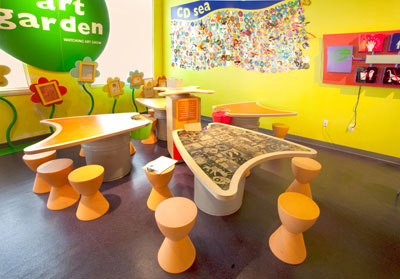
Museum of Contemporary Art (MOCA)
Founded in 1822, Jacksonville flourished as a port
and railroad hub in the late 19th century. The largest city in
Florida, it has the lion’s share of the Northeast’s major cultural
attractions – museums with outstanding kids’ programs, large concert
venues, and an award-winning zoo. With great weather almost
year-round, the city and its beaches offer plenty to do outdoors,
too. Due to the size of the city, it is essential to rent a car to
get around.
Key Sights
1. Cummer Museum of Art and Gardens
Play with digital paint on giant canvases, dance to create
colorful patterns, and explore all forms of art at the Art
Connections program in this museum.
2. Museum of Science and History
(MOSH) The KidSpace educational play area, a
next-generation planetarium, and a schedule of thrilling shows
make MOSH a huge draw for families.
3. Jacksonville Landing Shop at classy
stores, dine in the international food court, and catch exciting
events at this entertainment complex.
4. Museum of Contemporary Art (MOCA)
Five galleries filled with modern and contemporary art, plus
interactive fun at the ArtExplorium Loft await visitors at this
impressive museum.
5. EverBank Field From major concerts,
symphony performances, and outdoor festivals to NFL football
with the Jacksonville Jaguars, this 76,000-seat facility hosts
some of the biggest events in Jacksonville.
6. Adventure Landing and Shipwreck Island
Waterpark There is lots to please kids at this theme
park, including miniature golf, laser tag, go-karts, and a game
arcade, as well as water rides in summer.

Left Museum of Contemporary Art
Middle Adventure Landing and Shipwreck
Island Waterpark Right Cummer Museum of Art and
Gardens
Kids’ Corner
A river that flows north!
The St. Johns River is unusual
because, like the Nile in Africa, it is one of the
few rivers that flows south to north.
The river averages more than 2
miles (3 km) in width between Palatka and
Jacksonville.
It drops only 30 ft (10 m)
from its source to the sea, making it one of the
laziest rivers in the world.
Sharks’ teeth
You shouldn’t expect to find an enormous
tooth like you would see in a shop, though you might get
lucky. Check the patches of small shells along the waterline
for something tiny, black, and shiny.
Really the biggest?
Jacksonville is thought to be “the largest
city in the US” in terms of square miles. But that’s not
really accurate – it’s just the largest in the contiguous 48
states (the 48 that touch each other). Yakutat, in Alaska,
is really the largest city, with 9,459 sq miles (15,223 sq
km) of land area.
Saving sand dollars in the sandbank
The wide beaches of Jacksonville are
scattered with more than 50 kinds of local shells that are
fun to find and save. Look for lightning whelks, olives,
angel wings, baby’s ear moonsnails, scallops, and even a
“Florida jewel box.” The best time to find shells is at low
tide, especially in late fall, after storms.
< The
Northeast
2. Jacksonville Zoo and Gardens
Into the wild on a walking safari
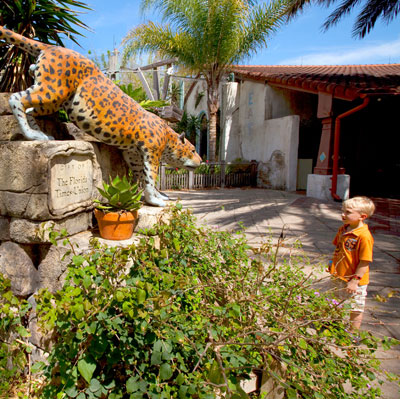
Entry to the Range of the Jaguar exhibit
Opened in 1914, Jacksonville Zoo started out with
just one red deer. Today, it has grown into an award-winning
regional zoo with more than 1,500 animals; among them are
fierce-looking Komodo dragons, playful gorillas and bonobos, docile
giraffes, high-spirited elephants in their massive pool, and
delightful penguins. Extensive boardwalks with specially designed
overlooks meander throughout this huge zoo, allowing visitors to
experience a “walking safari.”
Key
Features
1. Wild Florida Florida’s treasured
wildlife is the focus of this exhibit. Check out more than two
dozen species of reptiles and amphibians in the Reptile
House.
2. River Valley Aviary See a variety
of birds, from Inca terns to colorful macaws, in this aviary.
Also see the world’s smallest deer and the largest freshwater
fish.
3. Stingray Bay This interactive
exhibit allows visitors to observe, touch, and feed
stingrays.
4. Play Park Kids can cool off in the
huge Splash Ground or find their way out of a hedge maze in this
park. See penguins at close quarters in the Tuxedo Coast
exhibit.
5. Carousel and Zoo Train The classic
Wildlife Carousel with beautiful animal figures is a
kid-pleaser. Don’t miss a ride around the zoo on the Zoo
Train.
6. Asia and Australia While the Komodo
dragon exhibit steals the show at Monsoon Asia, kangaroos and
wallabies delight visitors at the Australian Adventure
exhibit.
7. Range of the Jaguar This
award-winning jaguar exhibit also features a replica of a Mayan
temple that is home to boa constrictors and bushmaster
snakes.
8. Africa Loop Walk along an elevated
boardwalk to view African animals, such as pelicans and zebras,
in re-creations of their natural habitat. The African Reptile
Building has cobras and mambas.

Left Carousel and Zoo Train
Middle Africa Loop Right
Stingray Bay
Kids’ Corner
Penguins quiz
The zoo’s Tuxedo Coast is home to
Magellanic penguins. Do you know how they differ from other
penguins? See if you can figure out if the statements below
are true or false:
They live on the coastline
of Argentina and Chile.
They were named for a
famous explorer.
Only one parent helps keep
the egg warm until it hatches.
They only eat plants.
Cheetah champs
If all the world’s four-legged animals
ever enter a race, you should bet on the cheetah to win –
they are the planet’s champion sprinters, able to run at a
speed of 70 mph (113 km/h).
Spot the jaguar
A baby jaguar doesn’t have to “grow into”
its spots – the kittens are born with plenty of them on
their yellowish fur. A jaguar’s special markings are called
“rosettes.” These are open rings that have up to four
different dark spots inside them. Some Native American
tribes believe the spots are like stars or suns, and that
the rosettes look like eclipses swallowing the stars.
< The
Northeast
3. Talbot Islands State Parks
Marshes, highlands, and rivers galore
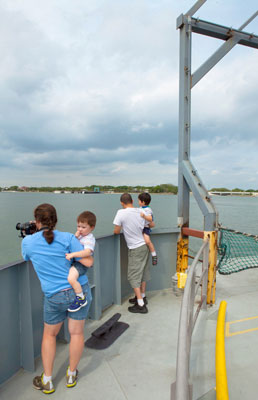
Aboard the St. Johns River Ferry from
Jacksonville
From marshes, highlands, and rivers, to 40 miles
(65 km) of Atlantic beaches, this remarkable cluster of state parks
offers a great chance to explore a broad range of natural habitats.
Families can choose from a wide variety of exciting outdoor
adventures including fishing, canoeing, kayaking, surfing, and
beachcombing. Be sure to carry sunscreen, insect repellent, drinking
water, and a picnic – the parks do not sell any food or drink.
Key Sights
1. Yellow Bluff Fort Historic State
Park Hike and picnic in this small peaceful park, a
Civil War site that was used as an encampment by both
Confederate and Union soldiers at different times.
2. Fort George Island Cultural State
Park Attractions here include the Ribault Club visitor
center and the Kingsley Plantation – the oldest plantation home in
Florida.
3. Little Talbot Island State Park
Noted for its stunning beach, the park offers campsites within
walking distance of the ocean, complete with picnic pavilions
and bathhouses.
4. Pumpkin Hill Creek Preserve State
Park A vast area of uplands with miles of hiking and
biking trails, this park also has great launch sites for
kayaking and canoeing.
5. Big Talbot Island State Park With
skeletal remains of oak trees scattered along its shore,
Boneyard Beach is this park’s best-known attraction.
6. George Crady Bridge Fishing Pier
This mile-long pedestrian bridge across Nassau Sound is a
favorite with North Florida anglers.
7. Amelia Island State Park Swim at a
beautiful beach, hike through the coastal forest, fish from the
shore, and kayak through creeks and marshes in this park.

Left Little Talbot Island State
Park Middle Skeletal remains of oak trees at the
Big Talbot Island State Park Right Fishing at
Amelia Island State Park
Kids’ Corner
Test your “bird brain”
See if you can spot the following birds at
the park, using these descriptors:
Sandwich tern These birds have shaggy black
crests (crown on the head) and yellow-tipped black
bills.
Laughing gull Look out for long, red beaks
and reddish-black to black legs.
Great blue heron These herons have very hairy
heads, chests and wings, and yellowish bills.
Black-masked bandits
If you’re camping in northeastern Florida,
a raccoon might want to steal your food. Just latching the
cooler won’t do. In one study, scientists found that it took
fewer than ten tries for raccoons to figure out complex
locks. Ask a park ranger for advice on keeping your food
safe from raccoons.
Digging into the past
Native Americans lived on the Talbot
Islands for thousands of years before Europeans arrived, and
the area was the site of dozens of little settlements and
hunting camps. More than 400 years ago, the Spanish mission
San Juan del Puerto was established on Fort George Island,
as well as smaller missions called visitas
(visitors). Archaeologists’ explorations indicate that one
named “Sarabay” was on Big Talbot Island.
< The
Northeast
4. Fernandina Beach
Shrimps and small-town charm
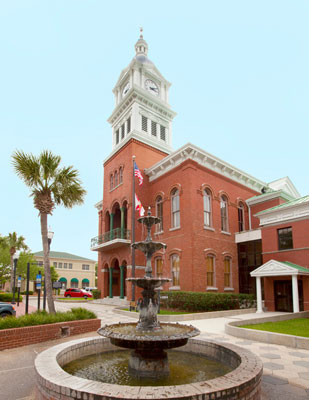
Old courthouse in the Historic District, Fernandina
Beach
Located on Amelia Island, with the Atlantic Ocean on
one side and the Amelia River on the other, this quaint and quiet
coastal town was the birthplace of the modern shrimping industry in the
US. The historic business district, around Centre Street, is bordered by
the docks, where visitors can watch the shrimp fleet return at sunset.
In the heart of Fernandina Beach, the 50-block Historic District is a
neighborhood of gorgeous Victorian-era buildings. Listed in the National
Register of Historic Places, the district is filled with shops and
restaurants. Stroll the streets on a self-guided or museum-led tour, or
take a trolley or a horse-drawn carriage, which kids are sure to enjoy.
Kids’ Corner
Fernandina’s flags
Fernandina Beach is the only place in the
US to have flown eight different flags. Can you find out
which governments these national flags represented?
Every year the town celebrates its history
with the Isle of Eight Flags Festival. Learn more about the
story on
www.shrimpfestival.com.
< The
Northeast
5. Fort Clinch State Park
Relive the Civil War
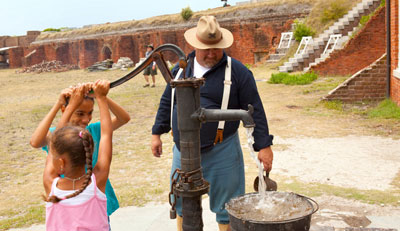
Kids learning how to work a water pump at Fort
Clinch State Park
Named for Duncan Lamont Clinch, a general in the
Seminole Wars (1816–58), Fort Clinch is more than just a historic
military site. In addition to the fort, the site has a beach, trails,
and campsites. Begun in 1847 to protect Fernandina Harbor, the fort was
built right where the St. Marys River flows into the Atlantic Ocean.
The clean, quiet beach is a major draw for swimmers and
sunbathers. Anglers frequent the beach to fish off the pier and the
finger jetties, or to make the most of excellent surf fishing
opportunities. Outdoor enthusiasts can walk the nature trails or bike
the off-road trails.
However, for many families the prime attraction is the
chance to see skilled re-enactors – or “living historians,” as the park
calls them – re-creating living conditions at the fort during the Civil
War (1861–5). Watch them perform kitchen and laundry chores, and at
times – to the delight of most kids – marching drills and artillery
demonstrations.
Kids’ Corner
Fort Clinch Quiz
Fort Clinch is five-sided,
which makes it: (a) an octagon (b) a hexagon (c) a
pentagon
Was the fort occupied by
Confederate forces or Union forces in the Civil
War?
Which of these can be seen at
the military site: (a) manatees; (b) alligators;
(c) ghosts
< The
Northeast
6. Cumberland Island National Seashore
In the lap of nature
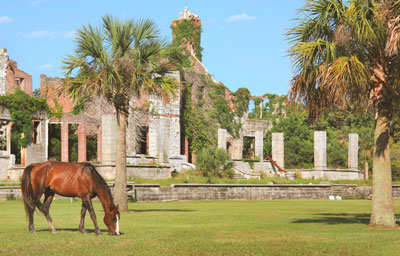
A wild horse at the Dungeness Mansion in Cumberland
Island National Seashore
Although Cumberland Island is just across the border,
in Georgia, visitors to Fort Clinch can see its southern edge across
Cumberland Sound. Unlike most barrier islands on the Atlantic,
Cumberland is not home to golf courses and gated communities, but to
pristine beaches, marshes, and a variety of bird and animal species. The
ferry ride from St. Marys is fun; lucky visitors may see dolphins
leaping near the boat. The island’s tranquil shell-strewn beach is a
treat for shell-collectors. Nature-lovers will love the hike trails
winding through maritime forests, wetlands, and even historic districts.
Look out for herds of wild horses grazing among the ruins of Dungeness
Mansion. The island also offers plenty of bird-watching opportunities.
Kids’ Corner
Wild horses at play
Do you know how a herd of wild horses
ended up on an island in the Atlantic Ocean? They may have
come to the area with Spanish explorers, or they may have
swum ashore from sinking 16th-century galleons. It’s thought
they’ve been here for centuries – maybe even as long as 500
years.
< The
Northeast
7. St. Augustine
A little bit of Spain
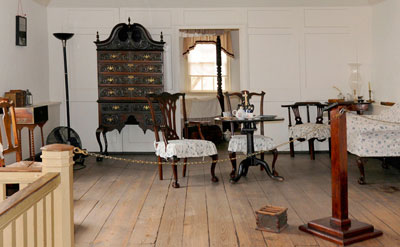
The González-Alvarez House
This remarkable city is home to living history
museums and elaborate Spanish-style architecture. Its historic
district includes 144 blocks, with a wealth of interesting sights,
restaurants, and unique shops. Spanning the Matanzas River, the
famous Bridge of Lions connects the city to
Anastasia Island, which has a classic striped lighthouse
and miles of white-sand beaches.
Key Sights
1. Villa Zorayda Museum Built in 1883,
this building is a one-tenth scale replica of a portion of the
Alhambra in Spain. Now a museum, it houses a superb collection
of artifacts from the Middle East.
2. Plaza de la Constitucioón
Surrounded by historic buildings, this shady square has been a
central part of the city’s life – from treaty ceremonies to
family picnics – for more than 400 years.
3. Bridge of Lions During Florida’s
land boom in the 1920s – when the city had plenty of money –
this historic landmark was built at an exorbitant cost, complete
with the marble lions that guard it.
• Oldest Wooden
Schoolhouse State-of-the-art Audio-Animatronic teachers
and pupils re-create life as it was in this cedar and cypress
school building more than 200 years ago.
• Oldest House The
González-Alvarez House is the oldest home to survive from the
city’s Spanish Colonial period. The complex has two museums, an
exhibition gallery, and an ornamental garden.

Left One of the marble lions on
the Bridge of Lions Middle One of the artifacts at
the Villa Zorayda Museum Right The Oldest Wooden
Schoolhouse
Kids’ Corner
Beach mouse
The Anastasia Island beach mouse is an
endangered species and is rarely spotted these days. Here
are some interesting facts about this little creature:
Home. It usually digs
burrows in the sand dunes or lives in the
abandoned homes of ghost crabs.
Food. Sea oats, other
coastal plants, and small insects make up its
diet.
Appearance. Its
light-colored coat helps it hide from predators
such as cats, dogs, and raccoons.
Anchored to the ground
The Oldest Wooden Schoolhouse building may
have survived several centuries, but it is fragile. In 1937,
the city was so worried it might blow away in a hurricane
that they wrapped a giant chain around the house and tied it
to an anchor!
Stone-faced lions
The Bridge of Lions, built at great
expense, is as much a work of art as a functional bridge.
The “Medici lions” were carved from Carrara marble – a white
or blue-gray marble often used in sculpture – and were a
gift to the city from former mayor Dr. Andrew Anderson, who
commissioned them from a studio in Florence, Italy.
< The
Northeast
8. Lightner Museum/Ponce de León Hotel
The charm of bygone days
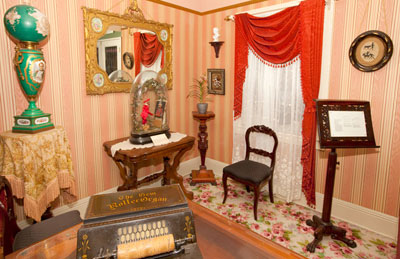
The splendid Victorian Music Room at the Lightner
Museum, St. Augustine
Commissioned by railroad tycoon Henry Flagler, (see
Flagler
Museum) these gorgeous Spanish Renaissance-style buildings were
created as the ultimate luxury hotels. Flagler intended the
Ponce de León Hotel to be “the world’s
finest hotel” of its time. Now a part of Flagler College, its splendid
carvings and curved arches are worth a look.
The Hotel Alcazar – now the Lightner Museum – was not quite as luxurious as the Ponce, but
it still offered a three-story ballroom, tropical gardens, a courtyard
for concerts, and spa facilities that included everything from Turkish
baths to the nation’s largest indoor swimming pool. The Lightner now
displays an elegant collection of items from the 19th century, including
cut glass, furniture, and paintings.
Kids’ Corner
Pirate vocabulary quiz
When it comes to pirate lingo, most of us
know what it means to “walk the plank,” but have you also
heard these terms?
Davy Jones’ locker
Pieces of eight
Grog
Avast!
The Jolly Roger
Avast, me hearties!
Not every pirate flew the same flag – in
fact, some famous pirates customized the Jolly Roger or
designed flags that incorporated their own symbols. In one,
the pirate Black Bart is toasting death, and in another
Christopher Moody, an 18th-century pirate, is threatening
violence if the victims don’t surrender – an hourglass warns
them time is running out.
< The
Northeast
9. Castillo de San Marcos
Cannons and a castle
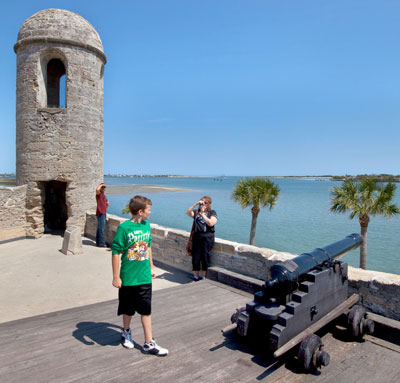
Cannon on the gun deck of Castillo de San Marcos,
St. Augustine
After the pirate Robert Searle attacked St. Augustine
in 1668, the town’s Spanish colonists decided they needed more
protection, and in 1672 they began constructing the massive Castillo de
San Marcos fort. Built of coquina rock quarried from just across the
river on Anastasia Island, it took 23 years to build. The Castillo’s
design included a seawall with floodgates that could be opened to fill
the moat if an assault threatened. Often attacked, the fort was never
taken by force, though it sometimes surrendered when faced with
overwhelming odds. For much of its history, this oldest existing masonry
fort in the US was used as a military prison.
There are lots of things to do here, such as exploring
the gun deck and secret chamber, and watching re-enactments. Kids will
enjoy the frequent cannon firings on weekends.
< The
Northeast
10. Environmental Education Center
Marine encounters
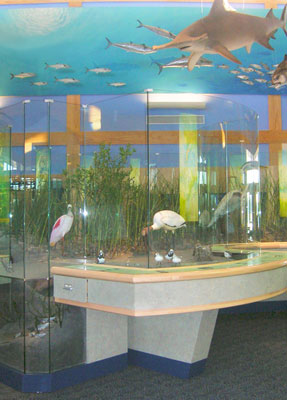
Natural exhibits in the Exhibit Hall of the
Environmental Education Center
A 10-minute drive north of St. Augustine is the Guana
Tolomato Matanzas National Estuarine Research Reserve (GTM NERR), an
environmental education center that is worlds away from the average
handful of exhibits visitors might expect to find there. The
$6.2-million center serves as a place for eco-educational activities for
the GTM NERR, a water system that protects more than 109 sq miles (282
sq km) along northeastern Florida’s coast.
The GTM center presents information about marine
creatures in several interesting ways. Visitors can see small specimens
in one of the three aquariums. Larger marine creatures are represented
by full-scale models. The very largest – a North Atlantic right whale –
hangs from the ceiling. There are also interpretive exhibits at the
center, a high-tech theater that screens nature films, and an outdoor
amphitheater.
Kids’ Corner
Is that right?
Why is the North Atlantic right whale,
sometimes seen off St. Augustine’s coast, known as the
“right whale”? The standard answer is that whalers of the
18th century saw the huge creature as the “right” whale to
hunt, but nobody knows if that story is true.
< The
Northeast
11. Anastasia Island
A spooky lighthouse
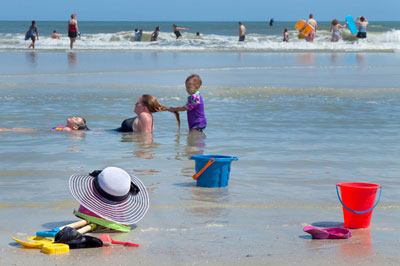
Fun at the beach in Anastasia State Park, Anastasia
Island
The 165-ft (50-m) St. Augustine
Lighthouse is definitely the high point of a visit to Anastasia
Island, but there are many other attractions, too. At the northern tip
is Anastasia State Park, whose 2.5 sq miles
(6 sq km) include 4 miles (6 km) of beach with a surf break, a maritime
hammock, a tidal salt marsh, and a sheltered lagoon favored by
windsurfers. It is possible to fish, hike, or bike around the park,
although most beachgoers come here to surf, sail, swim, or just enjoy
lazing in the sun.
Energetic families can climb the 219 steps to the top of
the lighthouse. Older kids and teens may be interested in a “Dark of the
Moon” ghost tour – the lighthouse was featured on Ghost Hunters,
a paranormal reality TV show. There is also an activity area for younger
kids.
Kids’ Corner
Haunted lighthouse
Don’t think ghosts exist? You might become
a believer after a nighttime “Dark of the Moon” ghost tour
of the St. Augustine Lighthouse. Visitors claim to have seen
and heard the ghosts of two little girls from the 1800s,
among others.
< The
Northeast
12. Marineland Dolphin Adventure
Is Flipper home?
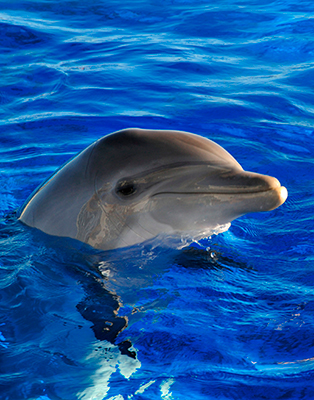
A bottlenose dolphin at Marineland Dolphin
Adventure
This attraction right on the Atlantic Ocean focuses on
research on Atlantic bottlenose dolphins and dolphin encounters. If
swimming with dolphins is on the “must-do” list, Marineland may be the
high point of a Florida vacation – a low-key, uncrowded environment
where it is possible to get close enough to rub bottlenoses. There are
several programs that offer visitors interaction with the dolphins, but
these must be booked in advance.
Children will enjoy exploring the dolphins’ natural
habitat in the adjacent Matanzas River Estuary. A Marineland partner
here offers kayak tours that are guided by certified naturalists. The
stable tandem- and triple-seat kayaks make the outing possible for
complete beginners, and even for kids as young as 6.
Kids’ Corner
Designer dolphins
Some dolphins at Marineland have been
trained to take soft bottles of paint in their mouths and
squeeze the paint up onto a canvas being held above them.
< The
Northeast
13. Washington Oaks Gardens State Park
For a fantastic day out
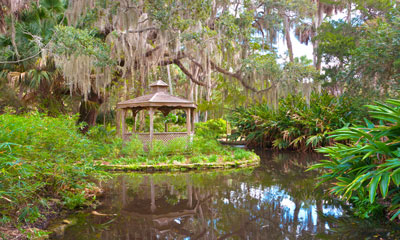
Picturesque view of a gazebo on a pond in
Washington Oaks Gardens State Park
Roses in the ornamental gardens, Ice Age rocks on the
beach – the two sides of Washington Oaks Gardens State Park couldn’t be
more different. Add to that the chance to see manatees hanging out in
the river shallows – and this state park is definitely not a run-of-the
mill picnic stop. Saltwater anglers can fish from the rocky beach on the
east side of A1A. The rocks make it a good place to hunt for sea glass
that’s been tumbled smooth. Budding anglers can try their hand at
freshwater fishing from the seawall on the Matanzas River on the west
side of A1A. In the cooler months, this is a good place to spot
manatees. The park gardens are also attractive – developed in the 1930s,
they include both native and exotic species. In early spring, visitors
are greeted by an especially beautiful sight: colorful azaleas and
camellias in full bloom.
Kids’ Corner
Manatee quiz
Manatees need to breathe air
every 20 minutes. Is that true?
Are manatees
(a) herbivores
(plant-eaters)
(b) carnivores
(meat-eaters)
(c) omnivores (plant-
as well as meat-eaters)?
Manatees are most closely
related to:
(a) elephants
(b) cows
(c) whales
Florida manatees can live for
up to:
(a) 10 years
(b) 35 years
(c) 60 years.
More about manatees
Manatees are intelligent and can learn
complex tasks. But they move slowly and don’t hear the
sounds of propeller-driven boats very well, so they’re often
injured or killed by boat strikes.
< The
Northeast
14. Daytona Beach
Fun on the run

The Southeast Museum of Photography
Daytona Beach has been drawing adrenaline junkies
since the early 1900s, when automobile-racing on the beach’s firm
sand pushed the boundaries of speed. Although the city is still
popular with race fans, it has also become a favorite destination
for millions of visitors each year, thanks to its beautiful beaches,
superb attractions, and great weather for outdoor activities.
Key Sights
1. Daytona Lagoon Although this
amusement park is all about water rides from May to October, it
also offers exciting year-round “dry attractions” such as laser
tag, miniature golf, and go-karts.
2. Daytona Beach Boardwalk Enjoy
old-fashioned arcade games and rides, such as a Ferris wheel,
Slingshot, and Hurricane, here. Check out the renovated pier and
restaurant.
3. Public beaches Car-friendly sands
and crowds of festive beachgoers have helped Daytona’s 23 miles
(37 km) of beaches gain a reputation as “The World’s Most Famous
Beach.”
4. Halifax Historical Museum This
museum features vintage toys and exhibits on Native American
culture, along with beach racing. A 20-minute movie covers
130,000 years of local history.
5. Southeast Museum of Photography
This is the largest museum of its kind in the Southeast, with
exhibits, lectures, and seminars, plus Family Photo Fun Days and
photo workshops for kids.
6. Daytona International Speedway
Young speed demons will like a tour of the legendary racetrack
of the Daytona 500, one of the most famous NASCAR meets.
7. Gamble Place This Florida
Cracker-style property preserves the Citrus-Packing House – the
only one in Florida at its original location.

Left Daytona International
Speedway Middle Ferris wheel at the Daytona Beach
Boardwalk Right Exhibit at the Halifax Historical
Society Museum
Kids’ Corner
Turtles in trouble
Unfortunately, there are many reasons why
sea turtles can end up needing some help at places like the
Marine Science Center. Those reasons can include:
Upwelling (really cold
water rising from the bottom of the ocean that can
shock and even kill hatchlings)
Washbacks (rough weather
pushing baby hatchlings back onto the beach)
Illegal fishing equipment
(hooks and fishing line that can get entangled or
swallowed by turtles)
Red tide (an algae bloom
in the water)
Picture this
When Joseph Niepce took the first photo in
1827, it took 8 hours. Since then, technology has made
possible some amazing photographs. One of the most famous
photos is “Earthrise,” taken by astronaut Bill Anders in
1968 while orbiting the moon. See it on
www.nasa.gov.
Lighting up the sky
The lighthouse at Ponce de
Leon Inlet features a beacon from the 19th
century. Can you guess how far out at sea the
light could be seen?
Do you know how long it takes
for the beacon to flash six times?
How many bricks did it take to
build the lighthouse?
< The
Northeast
15. Museum of Arts and Sciences (MOAS)
Not just another museum

Mold of the iconic Coca-Cola contour bottle
Set in the lush Tuscawilla Preserve, this museum
not only houses a superb collection of art, science, and history
exhibits, but also allows kids to discover important scientific
principles through hands-on exhibits, including the chance to design
cars and test their designs by racing against competitors. The domed
planetarium is another attraction here, with a Minolta MS-10 sky
projector. The preserve also has an environmental education center,
trails, and discovery stations.
Key Sights
1. “Sumar Special” Indy car Housed in
the Root Family Museum, the Sumar Special reached the amazing
speed of 172 mph (276.5 km/h) in 1957. It was designed by Frank
Kurtis and Chapman Root, whose company created the famous
Coca-Cola contour bottle.
2. Coca-Cola The mold of the original
Coke bottle is part of Chapman Root’s huge collection of
historic Coca-Cola memorabilia on display in the Root Family
Museum.
3. Teddy bears See more than 800 teddy
bears, each depicting a different theme or historical period, in
the Root Family Museum. Kids will love the large wedding party
in full costume, with a bride, a groom, and even a ring
bearer.
4. Giant ground sloth This
130,000-year-old 13-ft- (4-m-) tall skeleton of a giant sloth is
a major draw in the Bouchelle Gallery of Changing
Exhibitions.
5. Planetarium Located near the Root
Family Museum, this facility hosts thrilling solar
system-related shows using images from NASA space probes and 3-D
special effects.
6. Charles and Linda Williams Children’s
Museum Kids can race toy cars on the figure-eight track,
and also explore numerous exciting hands-on science stations in
this museum.
7. Cuban Foundation Museum Collection
Former Cuban president Fulgencio Batista donated the core of the
museum’s famed Cuban art collection in the 1950s. It is
considered to be the best collection outside Cuba.
8. Sculpture Garden This magical
outdoor exhibition area is dotted with works by noted
contemporary sculptors such as Ernest Shaw and Juan José
Sicre.

Left Skeleton of a giant sloth
Middle Exterior of the Charles and Linda
Williams Children’s Museum Right Teddy bears at
the Root Family Museum
Kids’ Corner
Ice Age giants
Once upon a time, huge Ice Age mammals –
some as big as a bus – lived in Florida, including these
below:
The scimitar cat was the
size of a lion, could run about 60 mph (96 km/h),
and had razor-sharp teeth.
The dire wolf was much
bigger and stronger than today’s timber wolves,
and hunted with up to 20 other wolves in a pack.
The giant terror bird, at
7 ft (2 m) tall, didn’t actually fly – and was a
carnivore (meat-eater).
Hunting for bears
The museum’s collection of teddies goes
far beyond the “bear” essentials! As you explore this giant
collection, try to discover the oldest, the newest, the
prettiest, and the ugliest bears. Can you try sketching
them?
Fossil find
In late 2011, a construction crew
discovered some weird bones just down the road from the
museum. The bones turned out to be from a 9-ft- (3-m-) tall
mastodon, which weighed about 10,000 lbs (4,536 kg) and
probably romped around Daytona about 50,000 to 100,000 years
ago. Check the museum’s website for more information.
< The
Northeast
16. Blue Spring State Park
Make a splash
When the summer’s hottest days roll around, families
love to take a refreshing plunge into Blue Spring, where they can swim,
snorkel, canoe, kayak, or take a riverboat tour. Certified scuba divers
can even dive here. With the onset of winter in mid-November, all water
activities stop as Florida’s manatees migrate here. The park is a
designated Manatee Refuge, and children will delight in watching from
the boardwalk as the manatees feed, frolic, and take care of their
calves.
Kids’ Corner
Manatees talk the talk
While it can’t be said that manatees have
their own language, they do communicate. Wonder what “Yikes,
danger!” or “Mom, I’m lost!” or “Now I’m mad!” would sound
like? To find out, go to
www.savethemanatee.org/coolstuff.htm and
click on “Sounds.” The website also has games, stickers, and
coloring sheets. Best of all, there’s also a webcam that
shows manatees at Blue Spring State Park.
< The
Northeast
17. Ocala National Forest
Tarzan’s playground

A picturesque hiking trail running through Ocala
National Forest
The second-largest National Forest in the country,
this 600-sq-mile (1,780-sq-km) jungle could take many years to explore
fully – from its sandy Big Scrub to the semitropical Juniper Springs.
Among the many attractions that appeal to families, the Yearling Trail
takes hikers to Pat’s Island, the place where the family in the Pulitzer
Prize-winning book The Yearling (1938) lived. Look out for the
endangered Florida black bear on the Florida Black Bear Scenic Highway
(State Road 19). The forest is also great for birding – spot bald
eagles, ospreys, waterfowl, and owls. Several lakes draw bass anglers,
and a full-facility marina rents boats. There are also campgrounds,
horse trails, and springs popular for swimming, canoeing, and tubing.
< The
Northeast
18. Ocala Thoroughbred Farm Country
Horsing around
Marion County, popularly known as “The Horse Capital
of the World,” is guaranteed to be a big hit with horse-crazy kids.
Watch a polo match or a real rodeo, get a close look at Thoroughbreds –
including the famous Rohara Arabians and Young’s Paso Finos – at one of
the 600 Thoroughbred farms in the area, or explore the countryside on
horseback at a ride-for-fun stable. Marion County boasts thousands of
national and world champs, plus six Kentucky Derby winners.
Kids’ Corner
Thoroughly thoroughbred
A Thoroughbred is a particular breed of
horse that is especially good at racing, jumping, and other
show events. These beautiful horses are usually about 64 in
(163 cm) tall, with a deep chest and a long neck. Those bred
to run longer distances are usually smaller, and the ones
meant to run shorter distances have bigger muscles.
The fastest two minutes in sports
The Kentucky Derby is a race for
3-year-old Thoroughbreds held each year in Louisville,
Kentucky. The race is 1¼ miles (2 km), and the winner is
draped with a blanket of roses. The 2015 Derby winner,
American Pharoah, was trained in Ocala.
< The
Northeast
19. Marjorie Kinnan Rawlings Historic State Park
House of a literary genius
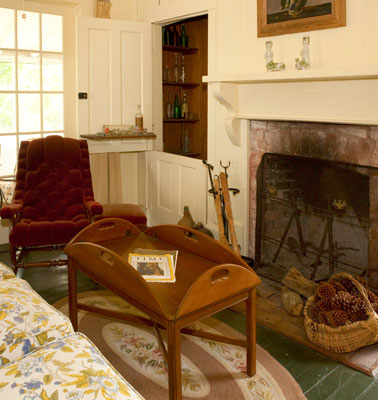
A room at the house in Marjorie Kinnan Rawlings
Historic State Park
Although she was not a native Floridian, Marjorie
Kinnan Rawlings’ writings about this area and its people have made her
one of the state’s best-known authors. She came to live on this
farmstead in search of a quiet place to write and fell in love with it,
as most visitors do, too. Her books, especially The Yearling,
which is a favorite among younger readers, help convey the realities of
living close to the wilderness in harmony with nature. The park includes
her home, furnished as it was when she lived here in the 1930s, a
workers’ home, a barn, a kitchen garden, and other outbuildings. The
home’s interior can be viewed only by guided tour.
< The
Northeast
20. Paynes Prairie Preserve State Park
Home on the range, where the deer and the
buffalo roam
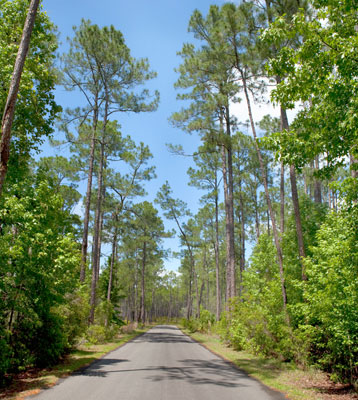
Tree-lined drive in Paynes Prairie Preserve State
Park, Gainesville
This 33-sq mile- (85-sq km-) preserve, 2 hours west of
Daytona Beach, is home to deer, bison, wild horses, Florida Cracker
cows, and alligators. It is not necessary to hike deep into the
wilderness to see its wildlife – the park has multiple observation
platforms, including a 50-ft (15-m) tower for a bird’s-eye view.
Remember to carry binoculars – 271 species of birds, from bald eagles to
sandhill cranes, live here. There is plenty of human history here to
explore, too. An audio-visual presentation at the visitor center tells
the story of this wilderness, which goes back at least 12,000 years.
< The
Northeast
21. Florida Museum of Natural History
Calling all “__ologists!”
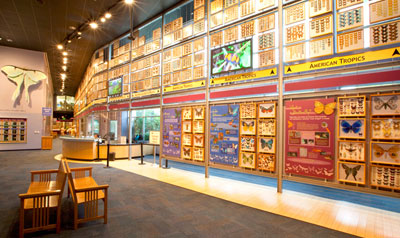
Butterfly exhibit in the Florida Museum of Natural
History, Gainesville
For families with kids who love science – whether they
want to grow up to be paleontologists, zoologists, or archaeologists –
the University of Florida’s Museum of Natural History in Gainesville is
an astonishing treasure house of information and exhibits. One of
American’s top five natural history museums, it houses more than 30
million specimens in multiple disciplines. Exhibits at the Hall of
Florida Fossils cover the last 65 million years in Florida, from the
Eocene era (when the state was underwater) to the arrival of humans
about 14,000 years ago. The McGuire Center, the largest research
facility on the planet dedicated to the study of butterflies, includes a
screened outdoor exhibit called the Butterfly Rainforest. This contains
hundreds of butterflies from all over the world, living in a
predator-free environment among waterfalls and tropical plants. On
weekend afternoons, when the weather permits, visitors can view live
butterfly releases.
Kids’ Corner
A hummingbird quiz
Are the following true or false?
Hummingbirds prefer red or
reddish flowers.
Hummingbirds get all of
their energy from sipping nectar.
Hummingbirds are one of
only three kinds of birds that can fly backward.
Many hummingbirds migrate
to Mexico in winter.
Which wings are which?
Most butterflies rest with their wings
held up, while moths spread theirs out flat. Check out the
Museum of Natural History’s butterfly guide at
www.flmnh.ufl.edu/butterflies/guide to
learn about butterflies.
< The
Northeast
22. Devil’s Millhopper Geological State Park
A sinking sensation
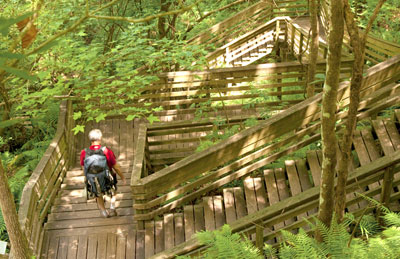
Steps leading to the bottom of the sinkhole in
Devil’s Milhopper Geological State Park
The Devil’s Millhopper, in Gainesville, is a sinkhole
that appeared when an underground cavern collapsed due to heat and
humidity. The sinkhole created a miniature rain forest with many small
springs whose streams flow down its sides. On a hot summer day,
descending all 236 steps to the sinkhole’s lowest point is rewarding for
its noticeably cooler temperature. Remember to wear stout shoes if you
are up for the walk. Though younger kids may find it exhausting, the
walk rewards the energetic ones with sightings of birds from the
pinelands and suburbs.
Kids’ Corner
What is a sinkhole?
Sinkholes are a common feature of
Florida’s landscape. They occur when loose soil, for
example, lies on top of some kinds of stone. Rain and
surface water gradually wash it through the cracks in the
stone into caves beneath, eventually causing a sinkhole.
The myth around Millhopper
According to legend, the Devil fell in
love with a beautiful American Indian princess. He chased
her, and the braves in the tribe raced after him, trying to
protect her. The Devil then created a deep sinkhole so that
the braves would fall into it. The story says that the
braves turned into the limestone rocks that line the
sinkhole’s sides.

